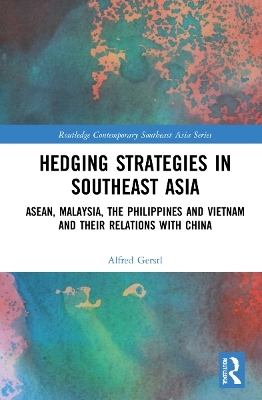
Hedging Strategies in Southeast Asia
Routledge (Verlag)
978-1-032-07940-0 (ISBN)
Introducing a re-conceptualized comprehensive hedging framework, this book analyses the relations of the Association of Southeast Asian Nations (ASEAN), Malaysia, the Philippines, and Vietnam with China in the context of the Belt and Road Initiative (BRI) and the South China Sea dispute.
The author argues that ASEAN and the three Southeast Asian governments pursue a hedging strategy towards the rising China. Hedging expands the strategic options of smaller powers which are in Neorealism often restricted to bandwagoning and balancing. A hedging strategy, however, can simultaneously contain both elements of bandwagoning (e.g., in economics) and balancing (e.g., in security affairs). Even though the four hedging strategies and their implementation vary, in principle they all seek closer economic relations with Beijing, while maintaining strong security relations with Washington. A major innovation of the new hedging concept is the inclusion of the perceptions of the hedger on the risks and opportunities stemming from the relations with the hedging target and of the strategic value of potential hedging partners.
The comprehensive hedging concept and the important empirical findings will be of interest to researchers in the fields of International Relations, Security, Political Geography, Economics, History, and Asian Studies.
Alfred Gerstl is Associate Professor at the Department of Asian Studies, Palacký University Olomouc, Czech Republic and Adjunct Professor at the University of Vienna, Austria. A specialist on International Relations in the Indo- Pacific, notably on Southeast Asia and China’s rise, symbolized in the Belt and Road Initiative, he is also President of the Central European Institute of Asian Studies (CEIAS), a transnational think tank.
1. The Belt and Road Initiative, Southeast Asia, and the South China Sea – an overview
2. The theoretical-methodological framework: A re-conceptualized hedging concept
3. ASEAN’s hedging strategy towards China
4. Malaysia’s hedging strategy towards China under Mahathir Mohamad 2.0
5. The Philippines' hedging strategy towards China under Rodrigo Duterte
6. Vietnam’s hedging strategy towards China
7. Conclusion: Similarities and differences of the four hedging strategies
| Erscheinungsdatum | 15.06.2022 |
|---|---|
| Reihe/Serie | Routledge Contemporary Southeast Asia Series |
| Zusatzinfo | 5 Tables, black and white |
| Verlagsort | London |
| Sprache | englisch |
| Maße | 156 x 234 mm |
| Gewicht | 453 g |
| Themenwelt | Naturwissenschaften ► Geowissenschaften ► Geografie / Kartografie |
| Sozialwissenschaften ► Politik / Verwaltung | |
| Sozialwissenschaften ► Soziologie ► Spezielle Soziologien | |
| Wirtschaft ► Volkswirtschaftslehre ► Makroökonomie | |
| ISBN-10 | 1-032-07940-1 / 1032079401 |
| ISBN-13 | 978-1-032-07940-0 / 9781032079400 |
| Zustand | Neuware |
| Informationen gemäß Produktsicherheitsverordnung (GPSR) | |
| Haben Sie eine Frage zum Produkt? |
aus dem Bereich


